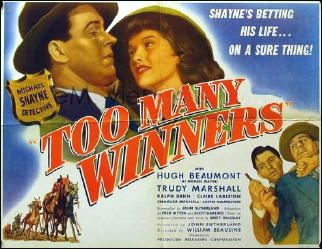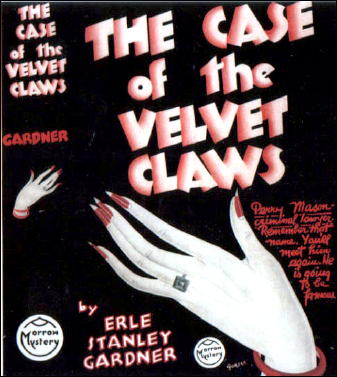July 2011
Monthly Archive
Sun 31 Jul 2011
A 1001 MIDNIGHTS Review
by Bill Pronzini
DAVID ALEXANDER – Hangman’s Dozen. Roy, hardcover, 1961.
David Alexander is an underrated writer, in part at least because he had an idiosyncratic, sometimes self-consciously poetic and mannered style that some readers find offputting. But his work has undeniable power, and his novels featuring sporting newspaperman Bart Hardin are superior portraits of New York’s Broadway and Times Square in the 1950s. His plots, too, are unusual and compelling, as are his offbeat, colorful characters.
Alexander was an even better short-story writer than novelist — certainly his prose was leaner and less eccentric in his short fiction — and the thirteen stories in Hangman’s Dozen are his best.
“The Man Who Went to Taltavul’s” (which won a prize in one of Ellery Queen’s annual contests) and “Something in the Air” are excellent historical tales with startling twists at the end. “The Other Ones” is a chilling fantasy about some of the murderous inhabitants of hell. “Run from the Snakes” concerns a wet-brain, an alcoholic so far gone that he no longer even knows who he is.
“Face of Evil” is a procedural about a cop named Romano, who appears in many of Alexander’s novels. “Love Will Find a Way” deals with three mountain climbers trapped by an avalanche and by their own passions in Switzerland, and the extraordinary crime perpetrated by two of them. The best of the hangman’s dozen is “Uncle Tom,” a devastating indictment of bigotry and racial injustice in the South — a story Alexander was unable to sell to any magazine in the Forties and Fifties.
This is a heterogeneous collection, illustrating the range and depth of the author’s talent.
———
Reprinted with permission from 1001 Midnights, edited by Bill Pronzini & Marcia Muller and published by The Battered Silicon Dispatch Box, 2007. Copyright © 1986, 2007 by the Pronzini-Muller Family Trust.
NOTE: Coming soon to a blog near you (this one), reviews by Marcia Muller and Bill Pronzini of The Madhouse in Washington Square and Paint the Town Black, both also by David Alexander.
Sun 31 Jul 2011
REVIEWED BY DAN STUMPF:
VICTORY. Paramount, 1940. Fredric March, Betty Field, Cedric Hardwicke, Jerome Cowan, Sig Ruman, Margaret Wycherly, Fritz Feld. Screenplay: John L. Balderston , based on the novel by Joseph Conrad. Director: John Cromwell.
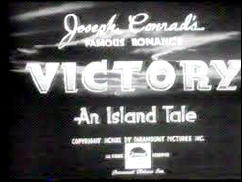
I’ve been trying to see Victory since I read about it in 1968. For some reason, however, Paramount retired the film and in the intervening umpty-ump years I’ve never once seen it listed on television or in a movie catalogue. All things come, however, to he who has Internet, and last month I finally found a copy—a bit soft, and bleached out in a couple spots, but watchable.
Victory is probably Conrad’s most-filmed novel, starting with a silent in 1919, (lushly directed by Maurice Tourneur, but somewhat over-balanced by Lon Chaney Sr as knife-wielding Ricardo) and ending, for now, with a 1995 film starring Willem Dafoe, featuring Rufus Sewell as Ricardo and Sam Neill as plain Mr. Jones — as nasty a pair of heavies as you could want — plus Irene Jacob as a poignant heroine.
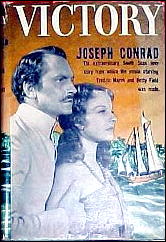
The 1940 film was adapted by John L. Balderston, whose credits range from Bride of Frankenstein to Prisoner of Zenda, who brought to the project sense enough to leave Conrad’s novel mostly intact. Direction came from John Cromwell, never a cinematic pioneer, but always able to do a thing up nicely — check out movies like Algiers, Dead Reckoning and The Enchanted Cottage to see what I mean.
Cromwell fills Victory with steamy jungles, sweltering hotels and blistering thunderstorms, but his main focus is on the actors, with Fredric March his usual fine self, and Betty Field a remarkably lovely heroine.
Field never achieved stardom, but she had major roles in important-looking pictures like Of Mice and Men, The Great Gatsby and King’s Row, and did very well by them—pperhaps she was too good an actress to be a star, but she trouped on to the end, finally trading insults with Clint Eastwood in Coogan’s Bluff. (1968.)
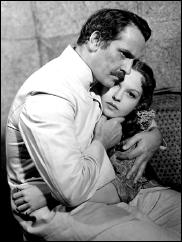
The acting triumph in Victory, though, goes to Sir Cedric Hardwicke and Jerome Cowan as plain Mr. Jones and Martin Ricardo; I honestly never knew these two could act like this. Hardwicke, usually the stuffy patriarch, plays Jones like a cross between Oscar Wilde and Lee Van Cleef, his every gesture languid and deadly, casually referring to past murder and dismissing it with a bored, “Ah well, it’s a long story. Another time perhaps.”
Even more surprising is Jerome Cowan, normally a rather uninspiring player, who comes on unshaven and cat-like, sporting a fine cockney accent and darting about the scenery as he pursues Betty Field with stylish lust. Given a chance to stretch a bit, Cowan and Hardwicke indulge themselves wonderfully, and together they make this a film to treasure and watch again.
Sun 31 Jul 2011
Posted by Steve under
ReviewsNo Comments
DEBORAH CROMBIE – A Share in Death. Charles Scribner’s Sons, 1993. Berkley, paperback, May 1994. Avon, pb, August 2003.
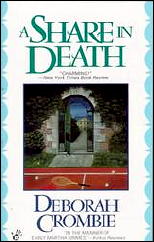
A Share in Death is the first of what is now fourteen books in author Deborah Crombie’s Duncan Kincaid & Gemma James series, both of Scotland Yard. Kincaid is a rising star in the ranks and a Detective Superintendent at the time this one takes place. We do not see much of Gemma. She’s a Sergeant newly assigned to Kincaid, and (we are told) they work as quite a team together.
But thanks to a cousin and his wife who couldn’t get away, Kincaid is off to Yorkshire at the beginning of the book, for a bit of pampering at a luxury timeshare he couldn’t begin to afford on his own, while Gemma is left to take care of loose ends back in London. And quite naturally murder soon occurs, then another, and Kincaid’s attempt at anonymity is foiled almost at once.
While of course anyone from the outside might have been the killer, the odds are highly against it. This is the present version of one of those old isolated manor house mysteries of the 30s and 40s, where the killer is one of the suspects, but which one?
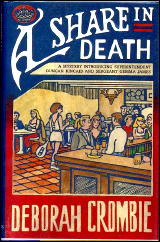
The Texas-born Crombie’s forte is description, characterization and dialogue, three big pluses that not every detective story writers has a full supply of, and which has made her books quite popular, following as they do the lives of the two lead characters throughout the series, as well as the cases they work on together. (A Share in Death was nominated for the Agatha and Macavity awards for Best First Novel of 1993, and the fifth in the series, Dreaming of the Bones, was nominated for a Best Novel Edgar by the MWA for Best Novel in 1997.)
I may not visit the right websites, however, as I haven’t read a lot about her, not as much as I think I should have, considering that she writes old-fashioned detective stories combined with the “cozy†aspects that present day fans seem to demand.
Description, characterization and dialogue: all three present and accounted for. The plotting I had some problems with. Not major ones, but when a suspect and possible witness starts to tell the investigating officer something, and they’re interrupted before they can say their piece, don’t your armchair detecting organs make you sit up and take notice? Mine do, and they did.
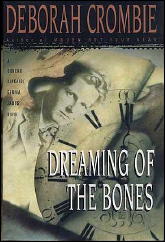
And it’s always a problem when the concluding chapter is the weakest of the book. The clues are all there – I checked to make sure – but it’s only under the barest of possibilities that Kincaid could have made the jump in logic that he did and come up with the identity of the killer, accurately, when he did. Maybe, I grant you, but only maybe.
The next would-be victim’s behavior is even more inexplicable, especially after a previous attempt on his/her life. Hie off by yourself to an isolated spot in the local countryside? Not me, not if it were I, not one chance in a thousand, and that’s the understatement of the year.
I tell you this not to dissuade you from reading the book, far from it. There is far too much good to it for that to be my intention. It does suggest that writing a puzzle to be solved in a mystery novel is much harder than anyone who has never tried it may think. For a first novel and these exceptions, A Share in Death is awfully good.
Sat 30 Jul 2011
WILL COOK – Killer Behind a Badge. Avon T-867; paperback original, 1960. John Curley, large print hardcover, 1994.
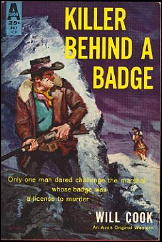
A western novel, and in only 128 pages, it packs a nifty punch. Will Cook, who also wrote as Wade Everett, James Keene, and Frank Peace, had the knack of summing up a person’s life history in just a few descriptive sentences.
Take, for example, the first paragraph of the book:
As was his habit each evening at seven, Bob Shannon left his hotel, crossed the street and walked a few doors down to Big Bessie’s Place, where he had his supper of chili beans and a double rye whiskey. This was the beginning of Shannon’s day, and it would not end until four in the morning; his office was a piano stool and a battered upright that had once graced a St. Louis bank president’s home.
The power in town belongs to Jefford Lane. From page 7:
The old man was fifty, blocky in the face and shoulders; there was about him the humorless stamp of hard work, and the first time you looked at him you knew that he had never heard a joke funny enough to laugh at.
The local law is in the hands of Manning Cordell. From page 8:
Shannon looked past them as the doors swung open and Manning Cordell came in. He was a man of medium height, not very heavy, and he wore a dark suit and flat-heeled boots. Before his appointment as U.S. Marshal, he had been a clerk in the courthouse, and many people in Cedar Springs were surprised that the government had made a law officer of him. Yet somehow he fit the job, for he was a quiet, dedicated man in his middle thirties, always serious and very thorough in the things he did. Not many people could recall a mistake Cordell had made.
I could go on, but these are three of the main characters, all important, if not essential, to the plot. Cordell is tough on lawbreakers, and Shannon is the only one who knows exactly how tough the Marshall is: judge, jury, and executioner, all wrapped up in one tidy package. As he explains to the faro dealer Elfrieda on page 33:
“I guess you could call it a solution. Some people might think it a good thing if a mad dog bit every bad person, but who gets rid of the dog?”
Here’s where the title of the book comes in. From this point on, it’s a game of wits to determine who will prevail, Shannon or Cordell, and all bets are off in terms of which way this terse and concise hardboiled little novel will go.
It gets a little choppy here and there — two cattle rustlers siding with Shannon are deposited in jail and never heard from again — but there’s a lot of tough action to go with some insightful perspective into the minds of the players.
And the ending is doubly satisfying, quite ironic in terms of a man who, having succeeded once, follows it up by making what’s clearly a terribly wrong choice. Very nicely done, and it’s quite unexpected. If you’re a western fan, be on the lookout for this one.
— Reprinted from Durn Tootin’ #3,
October 2003 (with revisions).
[UPDATE] 07-30-11. I have a feeling that the ending of this review was deliberately vague, so as not to any reveal significant plot points that I shouldn’t. Of course here it is, over eight years later, and I don’t remember the ending at all.
No matter. I trust my judgment. I recommended the novel then, and I still do now.
Fri 29 Jul 2011
TOO MANY WINNERS. Producers Releasing Corporation (PRC), 1947. Hugh Beaumont (Michael Shayne), Trudy Marshall (Phyllis Hamilton), Charles Mitchell (Tim Rourke), Ralph Dunn, Claire Carleton, John Hamilton, Ben Welden, Byron Foulger. Based on the novel Tickets for Death, by Brett Halliday (source uncredited). Director: William Beaudine.
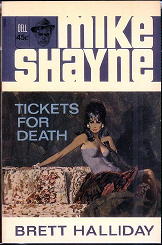
Neither of the usual sources (IMDB, American Film Institute) seem to know this, nor is Brett Halliday’s novel credited on the screen, but this final entry in the private eye Mike Shayne movie series was based on Tickets for Death (Holt, 1941), which I reviewed here on this blog over three years ago.
This is the last of five films in which Shayne was impersonated by Hugh Beaumont, which were preceded by seven in which Lloyd Nolan had the leading role. Beaumont does a better job than I expected in the part, especially after an opening scene in which Shayne and his secretary Phyllis Hamilton (played by Trudy Marshall) have great fun tootling each other with duck call devices, a means by which the producers of this film indicated that this was going to be a serious work of detective art.
According to a review on decoypro.com, the two are supposed to be going on a duck-hunting vacation together, but business seems to have a way of constantly interfering, to Phyllis’s great consternation. First, a gentleman stops by the office with $2000 in hand to persuade Shayne to give up the case he’s working on. This comes as a surprise to Shayne, since he’s not working on a case. Then he gets a phone call from a woman who has information he would like to have regarding, you guessed it, the case he’s not working on.
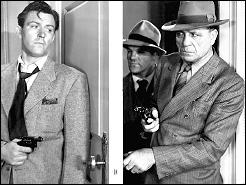
By this time, of course, there is nothing left but for Shayne to take the case, vacation (and unhappy secretary) or not. And what is the case? He’s hired by a racetrack to find out who’s been printing and cashing in on a flood of counterfeit tickets.
From this point on, there’s a lot of similarity between the book and the movie, though not completely, and if as I said in the book review, “Shayne runs into a lot of characters that both he and the reader have to keep constant track of,†it goes double for the film.
A sixty minute movie is simply too short for as much plot as there is in this one. I barely kept up, and that was only because I’d read the book. Audiences back in 1947 must have walked out of this movie in a daze, unless they just sat back and took it all in with their minds in an off position.
I enjoyed it, however, even though it’s a low-budget operation through and through, and in fact if I were to watch it again, it might even make sense. Great fun.
Fri 29 Jul 2011
Posted by Steve under
ReviewsNo Comments
MEREDITH FLETCHER – Best Man for the Job. Harlequin Romantic Suspense; paperback original, August 2011.
Bill Crider it was who suggested that this book might be worth reading, with a positive review on his blog, and all in all, he was correct. You can check out his review here before continuing on, if you wish.
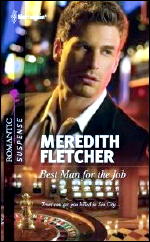
It wasn’t planned this way, but as it’s turned out, this is the third of three books in a row I’ve reviewed in which one of the leading characters is a female private eye. That Eryn McAdams works for a Las Vegas security firm doesn’t alter that fact, but it does mean that she’s not as much of a loner as either Kat Colorado or Kinsey Millhone. That she works for someone else and hasn’t reached anywhere near the top also means that’s not quite as good as either of her competition.
That this is romantic suspense novel means that there’s another leading character, male, and luckily they’re working on the same side of the case, even though Callan Storm is, shall we say, suspicious of Eryn at first. Not too surprisingly, since Eryn’s job at the pre-nuptuals stag party is to burst out of a cake dressed in almost nothing at all (as a last minute substitution).
And as she does so, so do the explosives go off, masked men rush in, and off they go with the groom to be. Callan, a member of an overseas Black Ops group, has been assigned by his sister (the bride-to-be) to watch over the wedding party and make sure nothing happens.
From this point on, as the twosome set out to track the kidnappers down before the police do, it’s non-stop action, with lots of gunfire mixed in with romance. The attraction to each other that both of them feel is a major point of the plot, as Meredith Fletcher tells it.
They can’t do it on their own, though, disappointingly. They need a third party who’s a computer whiz to do all kinds of magic tricks with cell phones, GPS devices, and hacking tools beyond the ken of mortal men. It sort of seems unfair.
Bill suggested that this book might not have been out of place if it had been published in the 1950s as a Gold Medal thriller. I wouldn’t go that far, though I know what he’s talking about. The action is fast and furious, with a few deaths along the way, but the romance elements are too strong and non-subtle for me. In terms of its goals the author set for herself? I think she succeeded on all counts.
Comparisons are hard. I wouldn’t say that Best Man for the Job is as good as the Kat Colorado book, the one I reviewed not so long ago, which had higher goals that I didn’t feel were met, but in many ways was still a better book. Apples and oranges, that’s for sure.
Thu 28 Jul 2011
THE BACKWARD REVIEWER
William F. Deeck
RICHARD GOYNE – The Lipstick Clue. Stanley Paul, UK, hardcover, 1954. No US edition.
Collectors of clergyman detectives may want to try Goyne’s series featuring The Padre — the Rev. Peter Eversleigh — whom I do not remember seeing on lists of clergy detectives.
One of the reasons The Padre may not have made such lists is that his denomination, at least in this novel, is not revealed, though I would speculate on High Anglican. Another reason, again at least in this novel, is that Eversleigh may as well have been a lawyer or a doctor or unemployed, for that matter.The religious aspect is negligible.
Still, the plot is a good one. A retired colonel, who is something more than a scoundrel, asks his estranged family to give him another chance as a father. For reasons unclear at the start, they all do come to spend the weekend with him, despite each of them despising him for various reasons. As is to be expected, the not-so-good colonel finishes the first night of the weekend dead to the last drop.
The Padre had been invited as a sort of leavening for the group. He ends up investigating the murder, discovering what is in some respects an unusual motive for killing, and learning who the murderer was. An interesting case that makes one not reluctant to read the other novels in which The Padre appears — for the detectival aspect, not for his role as a clergyman.
— From The MYSTERY FANcier, Vol. 12, No. 3, Summer 1990.
The Peter Eversleigh (The Padre) series —
The Crime Philosopher (n.) Paul 1945.
Savarin’s Shadow (n.) Paul 1947.
The Dark Mind (n.) Paul 1948.
Traitor’s Tide (n.) Paul 1948.
The Courtway Case (n.) Paul 1951.
The Lipstick Clue (n.) Paul 1954.
Besides a long list of books under his own name, Richard Goyne (1902-1957) is credited with another two dozen or so as by John Courage, plus a scattered handful under the names Aileen Grey, Scarlet Grey, Kitty Lorraine, Paul Renin & Richard Standish.
Other series characters under his own name are: Paul Templeton (13), Sexton Blake (2), and Supt. “Tubby” Greene (2).
THE FRONT COVER:
THE INSIDE FRONT JACKET FLAP:
A MORROW MYSTERY
To Readers of Detective Stories:
One day last December our editorial and sales departments agreed that too many mystery stories are being published in America and decided to accept no more such novels for at least six months. The next day two manuscripts were received. They were both by the same author. They were both detective stories. They were both accepted at once for publication.
The Case of the Velvet Claws is one of those manuscripts. The second will be published in the fall. (*) And both sales and editorial departments claim the credit for being the first to prophecy that Erle Stanley Gardner will find a place immediately as one of the most popular authors of detective fiction.
We hope that after reading this book you will agree we were justified in changing our minds.
* The Case of the Sulky Girl.
Perry Mason, criminal lawyer, is retained by a much-too-beautiful woman who obviously is concealing more than she is telling. She has heard that Perry Mason not only a law unto himself, but that he never lets a client down. She has been indiscreet, and is involved in blackmail.
The case is immediately complicated by murder, and Perry Mason finds himself as busy keeping clear of the law himself as he is in saving his client. The action is swift, dramatic, convincing. The handling and solution of the case are well developed and logical — perhaps because the author is a practicing lawyer with a trained legal mind.
Mr. Gardner’s writing has a style and personality of its own. His characters are colorful and vital. The lawyer, Perry Mason, and his charming secretary, Della Street, we believe, will become famous characters to all detective story enthusiasts.
WILLIAM MORROW & COMPANY
386 Fourth Avenue New York
THE INSIDE BACK JACKET FLAP: A detailed synopsis of –In Time for Murder, by R. A. J. Walling, a mystery novel also published by Morrow.
THE BACK COVER: A statement of the philosophy of the publisher relative to detective fiction, and a list of the titles they had recently published:
R. A. WALLING
Stroke of One
–In Time for Murder
CHARLES G. BOOTH
Those Seven Alibis
Gold Bullets
CHRISTOPHER BUSH
The Case of the April Fools
Cut Throat
WALTER F. EBERHARDT
A Dagger in the Dark
ROGER DENBIE (upcoming)
Death on the Limited (April 1933)
COVER PRICE: $2.00.
NOTE: Thanks to Bill Pronzini and Mark Terry for the cover images used to provide the information above.
SUE GRAFTON – “G†Is for Gumshoe. Henry Holt & Co., hardcover, 1990. Fawcett Crest, paperback, June 1991. Many later printings.
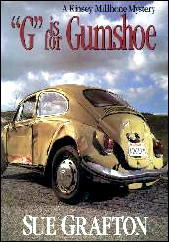
This is the one in which the titular gumshoe is not Kinsey Millhone, the PI who celebrates her 33rd birthday at the beginning — unless of course it is — but I really think it has to be a fellow named Dietz, who’s brought into Kinsey’s life soon after the 100 page mark (depending on which edition you happen to be reading).
He’s there as a bodyguard. As a direct consequence of a previous case that Kinsey helped solve, there’s been a hit man hired, she is the target, and the man is very very good at what he does. But so is Dietz, as Kinsey soon learns.
This is the interesting part of the book. Obviously the notoriously independent Kinsey Millhone does not want to have anyone holding her hand for her (figuratively speaking), but she soon discovers (as I pointed out in the paragraph above) that Dietz is good, and that on her own, she might not be good enough.
This is a sobering lesson. She also discovers that the two of them are kindred spirits who just happen to have never met before. (This comes as no special surprise.)
The part of the book that is not as interesting — in comparison — is the case she’s to been hired to do: find a woman’s 80-year-old mother who’s been living alone in an isolated part of the state (California) and hasn’t been heard of in quite a while. This sounds easy enough, and it is, but bringing the old woman back to San Teresa brings back memories too, and not so pleasant ones at that.
The results are what always happen when PI’s start digging into the past, and you will need a good genealogical chart to keep the participants straight, most of them dead and buried, but not all.
The ending of the hit man saga has the better climax of the two. We all know that Kinsey, who tells the story, will survive. It is Dietz that we are far more worried about — not knowing if he returns in later books or not — and that concern is what will have you turning the pages as fast as you can turn them, I guarantee you.
There are probably ups and downs in the Millhone series, and while I haven’t read all of them, I enjoyed this one. One thumb up. Unless I’m allowed to use both hands, in which case, two.
PRIME TIME SUSPECTS
by TISE VAHIMAGI
Part 5.0: Theatre of Crime (US)
Taking its cue from 1930s and 1940s radio drama, the U.S. television play format (initially a live presentation) gathered strength during the 1950s. Presented in various anthology series, the form evolved from live performances to filmed episodes (as developments in broadcast technology progressed).
Unlike contemporary British television (BBC), with its roots in theatre (the stage), American television drew on professional elements from Radio and from Hollywood (when the latter saw fit to work for the small-screen). By the 1960s, some of the on-screen results were simply astounding.
The Crime and Mystery genre was represented not only by some outstanding individual plays presented in general anthology series (such as Studio One) but also by entire anthology collections dedicated to the theme. Unfortunately, most of these genre-based anthologies tended to feature ordinary television suspense yarns (usually concerning devious murderers or remorseful fugitives).
I have, therefore, omitted many of these anthologies (such as Hands of Destiny, DuMont, 1950-51; The George Sanders Mystery Theatre, NBC, 1957; Panic!, NBC, 1957) from this overview.
In the beginning, Studio One (aka Westinghouse Studio One; CBS, 1948-58) appeared to have only one thing going for it, a brutally realistic adaptation of Dashiell Hammett’s “Glass Key” (May 1949). But then, later in 1949, another Hammett appeared, “Two Sharp Knives”.
It was the beginning of a Studio One deluge, sweeping in with “The Room Upstairs” (1950), from Mildred Davis, “Shield for Murder” (1951), from William P. McGivern, “Nightfall” (1951), from David Goodis, “Mr. Mummery’s Suspicion” (1951), from Dorothy L. Sayers, and “The King in Yellow” (1951), from Raymond Chandler.
In 1952 they presented “The Devil in Velvet”, from John Dickson Carr, “They Came to Baghdad”, from Agatha Christie, “Stan, the Killer” and, later, “Black Rain” (1953), from Georges Simenon, “Little Men, Big World”, from W.R. Burnett, and “The Hospital”, from Kenneth Fearing. 1953 saw “Sentence of Death”, from Thomas Walsh. In 1954 came “Let Me Go, Lover”, from Charlotte Armstrong.
By 1955 this deluge was down to a trickle, with “Donovan’s Brain”, from Curt Siodmak, and, in 1956, “The Talented Mr. Ripley”, from Patricia Highsmith. The final drops (genre-wise) were squeezed out with “First Prize for Murder” (1957), from John D. MacDonald, and “A Dead Ringer” (1958), from James Hadley Chase. Along the way, Studio One’s two-part “The Defender” (1957), by Reginald Rose, became the inspiration for the excellent 1961-65 series The Defenders (CBS).
Taking its title literally, Suspense (CBS, 1949-54) showcased stories by Cornell Woolrich, John Dickson Carr, Craig Rice, Stanley Ellin, Robert Louis Stevenson, Edgar Allan Poe, Joel Townsley Rogers, Arthur Conan Doyle, John Collier, Geoffrey Household, Georges Simenon, Wilkie Collins, and many others. But before the mouth-watering begins, it should be noted that these plays were broadcast live and therefore less than a third of them survive.
[Places like The Museum of Broadcast Communications in Chicago, Museum of Television and Radio in New York and The Paley Center for Media in Los Angeles may have viewing copies of some surviving episodes. Then, there’s always the Internet Archive – Moving Images – Television to explore: http://www.archive.org/details/television.]
Recipient of a Special Edgar Award in 1951, The Web (CBS, 1950-54) was a live New York series presenting stories from the works of the Mystery Writers of America (MWA). Tantalizing in the extreme, especially with so little to go on in terms of detailed episode credits, one can only imagine (fantasize, even) the possible selection of genre stories translated here for television.
Living up to its name, Danger (CBS, 1950-55) certainly satisfied its viewers with moments like Philip MacDonald’s “The Green and Gold String” (1950), John Dickson Carr’s “Charles Markham, Antique Dealer” (1951), Anthony Boucher’s “Mr. Lupescu” (1951), William L. Stuart’s “Blackmail” (1953) and Daphne du Maurier’s “The Birds” (1955). At the same time the series also promoted the early careers of directors Sidney Lumet and John Frankenheimer as well as actor James Dean.
Another live and prestigious series was Robert Montgomery Presents (NBC, 1950-57) which invested in some noteworthy episodes, particularly during the earlier seasons. Included were presentations based on works by Dorothy B. Hughes, Cornell Woolrich, Raymond Chandler (“The Big Sleep”, 1950), Wilkie Collins, Mary Roberts Rinehart, Hemingway (“The Killers, 1955) and Fredric Brown.
Inner Sanctum (NBC, 1953-54) featured stories based on the popular 1940s radio series, which included Edgar Wallace as story source for “The Lonely One” (1954) and author John Roeburt as a contributor of various teleplays.
Based also on a popular radio series was the earlier Lights Out (NBC, 1949-52). Similar in atmosphere and theme to Inner Sanctum, it presented stories by Edgar Allan Poe (“The Fall of the House of Usher”, 1949; “The Masque of the Red Death”, 1951; “The Pit”, 1952), August Derleth (“Rendezvous”, 1950), Dorothy L. Sayers (“The Leopard Lady”, 1950), Ira Levin (“Leda’s Portrait”, 1951), Fredric Brown (“The Pattern”, 1951) and Cornell Woolrich (“Nightmare”, 1952).
Filmed at Elstree in England for NBC, Douglas Fairbanks Jr. Presents (NBC, 1953-57; ITV/UK from 1955) presented one particular episode which is worth being celebrated by fans of the genre because it represents the only proposal (to my knowledge) for a Bulldog Drummond TV series: the half-hour pilot episode “The Ludlow Affair” (NBC, 1957), with Robert Beatty as our hero and the scene-stealing Michael Ripper as his sidekick.
Climax! (CBS, 1954-58) got itself off to an enterprising start with Chandler’s “The Long Goodbye”, starring Dick Powell again as Marlowe, and followed it up quickly with Bayard Veiller’s “The Thirteenth Chair”, Fleming’s “Casino Royal” and Lucille Fletcher’s “Sorry, Wrong Number”.
The rest of its TV treasures consisted of works by Mary Roberts Rinehart, Eric Ambler, A.A. Fair [Erle Stanley Gardner], John D. MacDonald, George Hopley [Cornell Woolrich], Patricia Highsmith, Ursula Curtiss, Charlotte Armstrong, Ed McBain [Evan Hunter], and John Dickson Carr.
Warner Brothers Presents (ABC, 1955-57) was the umbrella title for Conflict (ABC, 1956-57), an anthology presenting compositions by Frederick Brady and Thomas Walsh as well as the first pilot (“Anything for Money”, 1957) for the influential 77 Sunset Strip (ABC, 1958-63).
Lux Video Theatre (CBS, 1950-54; NBC, 1954-57) ran for some seven years, but the NBC seasons were the ones that were of the most interest. During this period the series began featuring teleplay adaptations based on screenplays from some notable Hollywood movies. For instance, there was “Double Indemnity” (1954), “So Evil My Love” (1955), “Shadow of a Doubt” (1955), “My Name is Julia Ross” (1955), “The Suspect” (1955), “Suspicion” (1955), “Ivy” (1956), “Witness to Murder” (1956), “Mildred Pierce” (1956), “The Guilty” (1956) and “The Black Angel” (1957).
The first genre anthology to be filmed by a major studio (Universal), Alfred Hitchcock Presents (CBS, 1955-60; NBC, 1960-62) has over the decades acquired something of a mystique of its own.
Utilizing the art and craft of many screenwriters, big-screen actors and like-minded directors, the series’ producers (Joan Harrison and, later, Norman Lloyd) provided a wonderful insight into the workings of the famed Hitchcock (his Shamley Productions produced the series for which he was executive producer). Hitchcock was also savvy enough to explore the work of a vast range of lesser-known genre authors.
Story sources for Alfred Hitchcock Presents include Lillian de la Torre, C.B. Gilford, Michael Arlen, Norman Daniels, Richard Deming (1915-1983), Henry Slesar, Lawrence Treat, Roy Vickers, Harold Q. Masur, Brett Halliday [Davis Dresser], Margaret Manners, Helen Neilsen, Anthony Gilbert [Lucy Beatrice Malleson], Dorothy Salisbury Davis, and Ed Lacy.
It may not come as too much of a surprise to many readers that the highly-praised 1960 film Psycho was made at Universal by Hitchcock’s TV team, conspicuous by the striking monochromatic imagery of Shamley’s cinematographer John L. Russell.
The series was revived by NBC (1985-86) and featured colorized Hitchcock intros of the now-deceased host from the original 1950s show. Befittingly macabre or merely mindless? Then, USA Cable Network continued the title (1987-88) with some additional episodes.
Hitchcock’s Shamley Productions turned to NBC for Suspicion (NBC, 1957-58), even while Alfred Hitchcock Presents was still running over on CBS. The series consisted half-and-half of filmed (Shamley) and live presentations, including Woolrich’s “Four O’Clock”, Helen McCloy’s “The Other Side of the Curtain”, and the rarely-seen “Voice in the Night” (1958) by William Hope Hodgson. “Eye for an Eye” (1958) was the pilot episode for Ray Milland’s 1959-60 private eye series Markham (CBS).
Kraft Television Theatre became Kraft Mystery Theatre (NBC) for the summer of 1958. The series presented many fine and unexpected works, most notably Ed McBain’s [billed as Evan Hunter] “Killer’s Choice”, the Larry Cohen-scripted “The Eighty Seventh Precinct” [from the McBain novels] and “Night Cry” [from the 1948 novel by William L. Stuart; filmed in 1950 as Where the Sidewalk Ends]. Kraft Television Theatre was the last of the live shows when it faded in 1958, everybody else having already turned to filmed recordings.
There is one particularly interesting episode of the anthology Pursuit (CBS, 1958-59): “Epitaph for a Golden Girl” (1959), adapted by Lorenzo Semple Jr. from a short story by Ross MacDonald. The story originated in EQMM in June 1946 as “Find the Woman,” with MacDonald writing as Kenneth Millar. In the Pursuit adaptation, star Michael Rennie’s private detective is now called Rogers (instead of Lew Archer).
In April 1959, Westinghouse Desilu Playhouse (CBS, 1958-60) presented writer Paul Monash’s two-part “The Untouchables” which served as a suitably violent introduction to the popular and controversial series The Untouchables (ABC, 1959-63). The series helped launch the action-filled 1959 to 1962 television gangster phase (to be a later Part in this TV history overview).
A second Part of this “Theatre of Crime (US)” will follow shortly, concluding the US history of the genre anthology from the 1960s onwards.
Note: The introduction to this series of columns by Tise Vahimagi on TV mysteries and crime shows may be found here, followed by:
Part 1: Basic Characteristics (A Swift Overview)
Part 2.0: Evolution of the TV Genre (UK)
Part 2.1: Evolution of the TV Genre (US)
Part 3.0: Cold War Adventurers (The First Spy Cycle)
Part 3.1: Adventurers (Sleuths Without Portfolio).
Part 4.0: Themes and Strands (1950s Police Dramas).
Part 4.1: Themes and Strands (Durbridge Cliffhangers)









